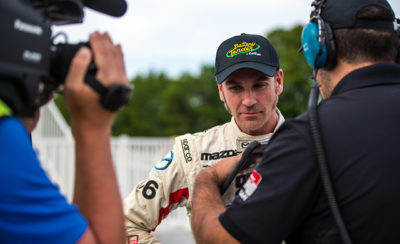Whether you’re a die-hard club racer, autocrosser or an aspiring pro, at some point you may want to spread the word about what you’re doing. Here are some tips
If you aspire to become a professional racer, are a club racer with something to crow about, or you want to bring attention to a good cause, you’ll want to get the word out. While the drivers for Mazda Team Joest have a professional public relations person to handle that for them, you’ve got to do it yourself. So MazdaMotorsports.com turned to that professional PR person and also the head of the agency that handles PR for the Idemitsu Mazda MX-5 Cup presented by BFGoodrich Tries to discover the basics.
While the first thing that comes to mind with the term “public relations” is media coverage, quite often that’s neither the goal nor the best course of action. There are others with whom you may need or want to communicate; supporters, potential supporters, friends and family, all may have an interest in what you’re doing. So while we may dream of getting our story told in the local paper or television news program, there are other, more intimate audiences that might be more crucial to success.
Before that happens, though, it is critical to learn how to communicate. One media person we spoke to mentioned that some racers have no idea how to tell their own story. If you don’t have that skill then you need to develop it, explains Efrain Olivares, a longtime PR professional who handles communications for Mazda Motorsports and Mazda Team Joest.
“The ability to be comfortable in front of someone with a camera, comfortable in front of someone with a microphone, is a kind of pressure that most don’t realize is something that needs to be worked on and developed,” says Olivares. “I had a conversation with a young driver and his family over the winter, and I said, ‘If you have the ability to do so in your school, you need to sign up for debate. Go sign up for public speaking and become very, very good at it.’
“If you can handle being in a debate or public speaking in front of a large audience, you can handle almost anything your race car career is going to throw at you,” he explains. “There’s nowhere to hide; it’s really just you out there, and all of your inadequacies and insecurities are going to come out. Be someone who’s well spoken, can communicate your thoughts clearly, and also learn when not to say something before you’re thrown into a situation where you’re representing a team, or sponsor, or a series and someone has got a camera on you.”
The next step is to have a story to tell. Racing alone doesn’t make your journey compelling. You won an SCCA U.S. Majors Tour race? So did 28 other racers that same day at that same track. There needs to be something more to it, such as winning every Majors race you entered that year – “There’s no better PR than winning,” says Olivares.
Matt Cleary, owner of Sunday Group Management that handles PR for Idemitsu Mazda MX-5 Cup among other series and drivers, mentions a charitable cause is often a good hook, and cites one MX-5 Cup driver as an example.
“Nathanial Sparks donated the livery of his car to Lemons of Love, and he won the first he race he did that with in 2017 at Road America,” Cleary explains. “He positioned himself to have a doubly good story. He had done this thing to create awareness for a charity, and he also integrated it by hosting kids battling cancer at the track. Then he doubled his efforts by winning the race, right? He had already set the stage for a compelling narrative and he closed the deal by having the performance to match the effort. It was story that people picked up beyond, ‘Oh, this guy won the race.’”
A charitable cause, as cited in this case, is not only a good way to get people to tell your story, but it’s also a compelling reason for a driver or team to seek media attention, although Cleary emphasizes that it be done with honest intentions and not solely for the purposes of attention.
There are other elements that will attract attention because they make for a good story; family angles, racing with a disability and overcoming barriers are all good stories to tell. Ultimately, a racer needs to figure out what makes him or her unique compared to the other few hundred people racing on any given weekend.
“People way overuse the expression, ‘turning yourself into a brand,’” says Cleary. “All that means is that you are different from other people, and you need to find a way to positively highlight the differences between you and other people. Knowing who you are and what you want to relay is important to consider before you go projecting and trying to develop your audience.”
In the next installment, we’ll look at how to tell that story, and get others to tell it for you.


 ACCESSIBILITY
ACCESSIBILITY